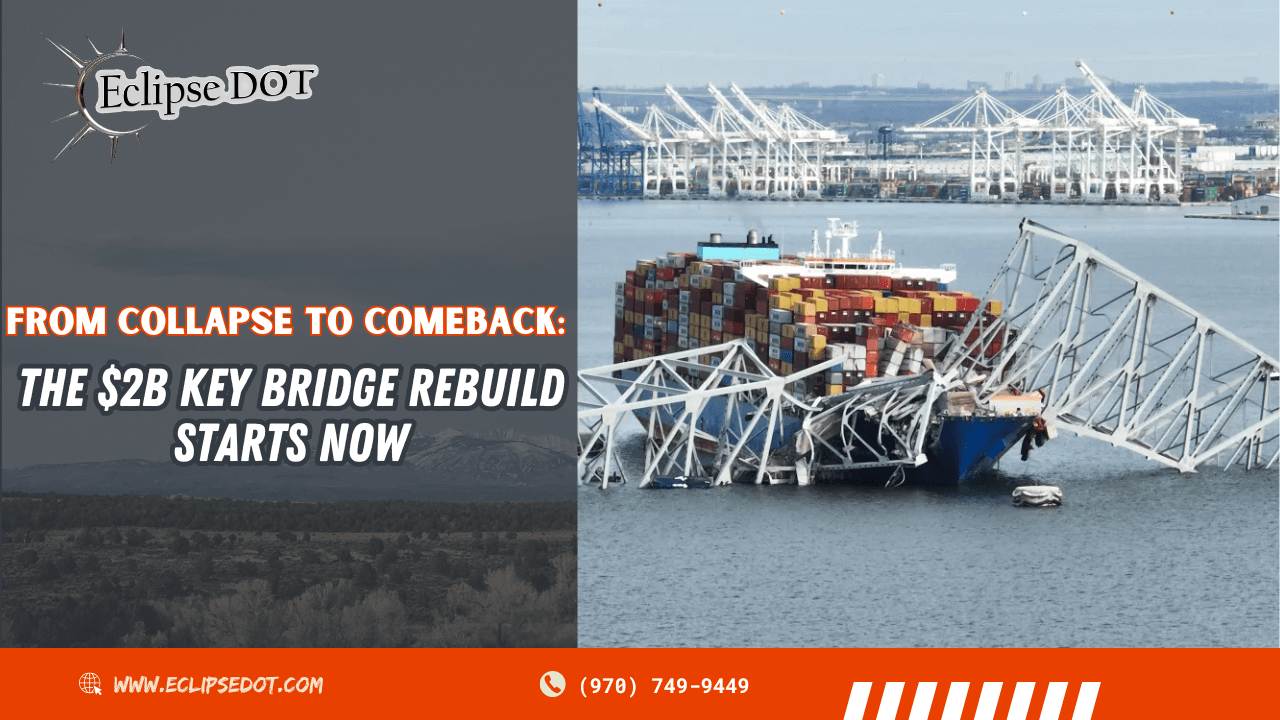What do you do when life or, in this case, a runaway cargo ship knocks down one of your most iconic bridges? You don’t sit around crying about it. You roll up your sleeves, rally your team, and get ready to build back better, bolder, and stronger. That’s exactly what Baltimore is doing with the Francis Scott Key Bridge, and thanks to a hefty $2 billion in federal funding, it’s all systems go starting this month.
The Maryland Transportation Authority (MDTA) is spearheading the four-year mission to turn rubble into resilience. Pre-construction kicks off January 7, and before you know it, you’ll see cranes, hard hats, and demolition crews swarming the area. But let’s be clear, this isn’t your average “patch it up and hope for the best” deal. We’re talking about a full-on bridge makeover with modern design, cutting-edge tech, and safety features so advanced even the most rebellious cargo ship will think twice before pulling another stunt like last year’s disaster.
March 26, 2024: The Night Baltimore Stood Still
Let’s take a walk down memory lane, not the fun kind, but the kind that makes you wince a little. It was 1:30 a.m. on March 26, 2024, when disaster struck. A giant cargo ship, Dali, lost electrical power and crashed headfirst into the Francis Scott Key Bridge. The result? Total chaos. Part of the bridge collapsed into the Patapsco River, taking eight roadworkers with it. Six of those workers—everyday heroes just doing their jobs—tragically didn’t make it home.
The Port of Baltimore, one of the busiest and most vital in the U.S., shut down immediately. Millions of dollars in cargo shipments were delayed, traffic was rerouted, and the city was left scrambling to pick up the pieces. It wasn’t just a bridge that fell, it was a lifeline for the region’s economy.
But let’s be real, this wasn’t just a tragic accident. It was a wake-up call. A reminder that old infrastructure + high traffic + bad luck = disaster waiting to happen. And Baltimore heard that call loud and clear.
Show Me the Money: How Maryland Scored $2B in Federal Funding
Rebuilding a bridge like this isn’t a weekend DIY project. It takes serious cash, and Maryland knew it needed Uncle Sam’s wallet to get the job done. Enter President Joe Biden, stage left. In true action-hero style, Biden didn’t waste any time approving $60 million in emergency relief to clean up the debris and get the port back in business.
But $60 million was just a band-aid. Maryland needed the full works—a massive $2 billion to build a new bridge from scratch. Governor Wes Moore wasn’t shy about making the ask, and by November, Biden was putting pen to paper, requesting Congress to foot the bill. Fast forward to December, and boom: Congress said yes, stuffing the $2 billion Key Bridge rebuild into a $100 billion disaster relief package.
Governor Moore summed it up best: “This isn’t just about replacing a bridge—it’s about building a future where our infrastructure is stronger, safer, and ready for whatever comes next.”
Translation? Maryland gets a shiny new bridge, and taxpayers don’t have to break a sweat about covering the cost. Win-win, baby!
The Plan: Turning a Tragedy Into a Triumph
Now that the funding’s locked and loaded, what’s the plan? The MDTA has handed over the reins to Kiewit Infrastructure Company, a crew known for turning blueprints into masterpieces. Their $73 million contract covers everything from design to construction, and they’re pulling out all the stops to make sure this bridge isn’t just good—it’s great.
Here’s what’s on the menu:
⭐ Reinforced supports that can handle everything from a passing cargo ship to Mother Nature’s mood swings.
⭐ Smart sensors that’ll keep tabs on the bridge’s health 24/7, because an ounce of prevention is worth a ton of repairs.
⭐ Better traffic flow with more lanes and smarter design to cut down on congestion.
Oh, and did we mention it’ll be built to last? Because when you’re dropping $2 billion on a bridge, you don’t want to be back here in 20 years doing the whole thing over again.
Pre-construction activities surveying, scanning riverbeds, and soil sampling, start in January. The real action kicks off in spring when demolition crews move in to clear out what’s left of the old bridge. And if everything goes according to plan (fingers crossed), we’ll be cutting the ribbon on the new bridge by October 2028.
Why This Matters: Beyond Bricks and Steel
Sure, building a bridge is impressive, but this project is about more than just bricks and steel. The Key Bridge is a key player (pun intended) in Baltimore’s economy. Before the collapse, it carried millions of tons of cargo to and from the Port of Baltimore every year. Without it, supply chains suffered, businesses lost money, and the whole region felt the ripple effect.
Rebuilding the bridge is about restoring that economic lifeline. It’s about creating jobs, boosting trade, and making sure Baltimore stays competitive in the global market. And on a personal level, it’s about giving the city a reason to hold its head high again.
Safety First: Lessons Learned and Applied
One of the hardest lessons from the collapse was that infrastructure can’t be taken for granted. The new Key Bridge will feature top-tier safety upgrades to make sure history doesn’t repeat itself. These include:
✅ Collision-resistant supports built to withstand impacts.
✅ Advanced monitoring systems to catch potential issues before they become problems.
✅ Enhanced traffic control to improve safety for both drivers and maritime operations.
Meanwhile, the FBI and NTSB are continuing their investigations into the Dali incident. Early reports suggest the ship experienced multiple electrical failures before crashing into the bridge. In a move to cover cleanup costs, the ship’s owners have agreed to pay $102 million to the federal government.
Honoring the Fallen: A Memorial in the Works
This rebuild isn’t just about infrastructure, it’s about people. Plans are underway to create a memorial near the bridge site to honor the six roadworkers who lost their lives. It’ll serve as a lasting tribute to their memory and a reminder of the importance of safety in everything we build.
From Tragedy to Triumph: Baltimore’s Comeback Story
In the end, this $2 billion project is more than just a bridge, it’s a symbol of Baltimore’s resilience, strength, and determination to bounce back from adversity. It’s proof that when things fall apart, we don’t just rebuild, we build better.
So, buckle up, Baltimore. The road from collapse to comeback starts now, and it’s going to be one heck of a ride. Eclipse DOT will be here every step of the way, bringing you updates, milestones, and maybe even a few fun facts about bridge building (because who doesn’t love a good construction saga?).
Stay tuned, stay safe, and remember: if you see a need, fill a need especially when it involves billion-dollar bridges.
Gain exclusive access to our CDL & DOT Compliance articles with a trial at DOTDocs.com. And don’t forget to claim your FREE micro audit at THE ECLIPSE DOT MICRO AUDIT. Ready for seamless operations? Discover the difference today!


